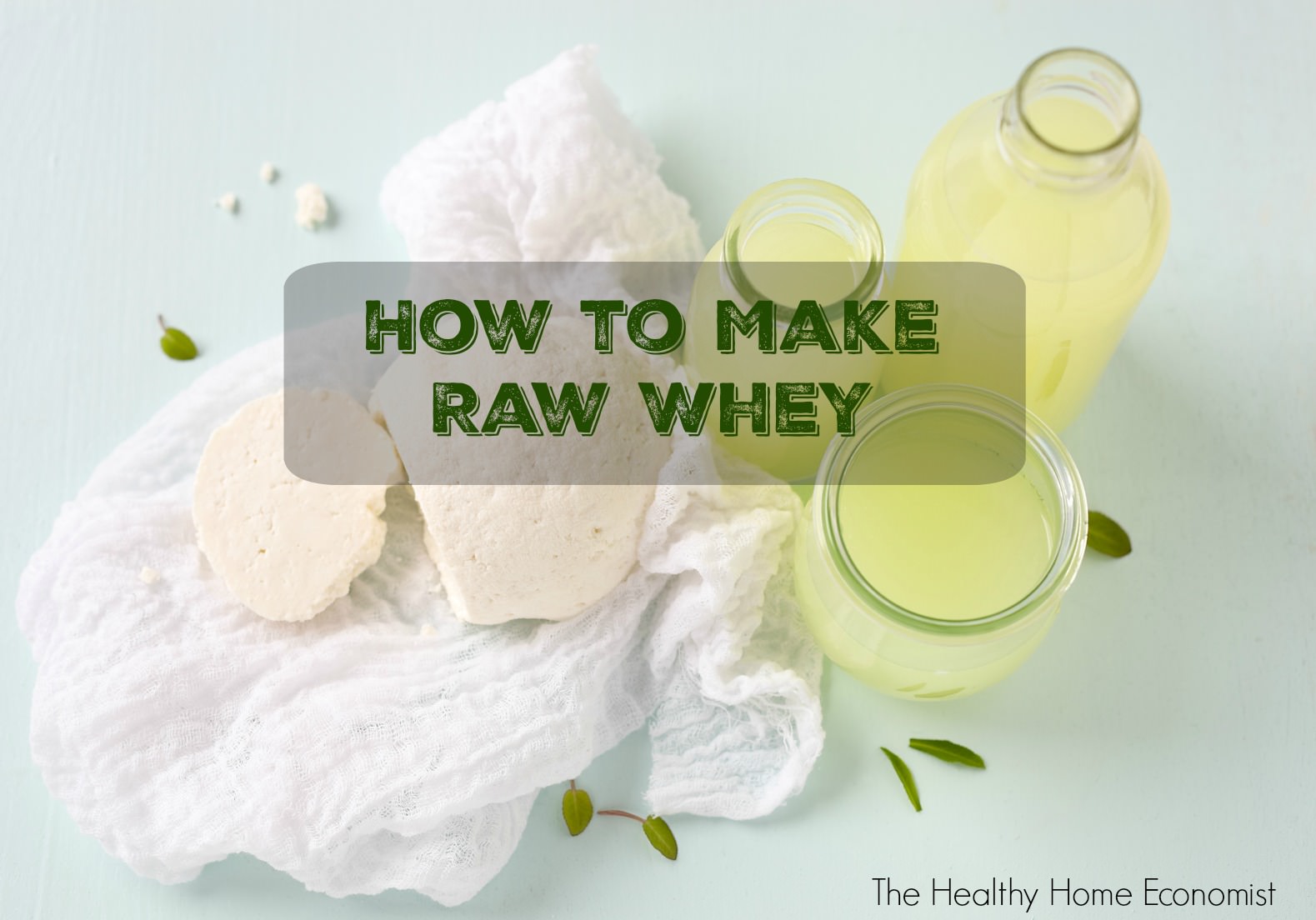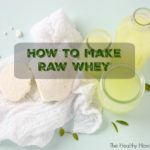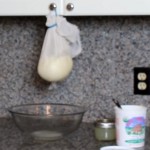How to make raw, enzyme and probiotic-rich liquid whey to use as a starter culture for all your home fermentation needs.

Do you know how to make whey from yogurt, kefir or raw milk?
A by-product of this simple technique is healthy homemade cream cheese that is loaded with enzymes and probiotics.
The recipe below describes how with visual instructions via video demonstration!
Making homemade baby formula? I recommend using this “quick whey” no straining method as the fastest and easiest approach.
How to Make Whey the REAL Way
Making real, liquid, nutrient rich, unadulterated whey in your own kitchen is a MUST step for any traditional cook to learn.
Without whey in its whole, liquid form, many other traditional recipes cannot even be attempted. You cannot buy whey from the store except in a denatured, unhealthy, powdered whey form. It is worth your time to learn what I show you in the video below.
Other video lessons on this blog show you how to use this whole food form of whey to make many delicious, healthful recipes for your family. Whey as made in the video demo below will keep up to 6 months in the refrigerator in a sealed mason jar.
If you absolutely have no access to farm fresh milk to make whole, unadulterated, enzyme rich whey, then you can use plain, organic yogurt brand from the store instead. Here are tips on how to spot the best yogurt brands.
The process is basically exactly the same thing as shown in the video.
You won’t get nearly as much whey using yogurt as clabbered, farm fresh milk, but at least you can get enough to get you started.
Wonderful Whey and REAL Cream Cheese
The raw, enzyme-rich cream cheese I make in the recipe video below is fantastic on a sprouted or sourdough bagel for breakfast. Don’t buy the Ezekiel sprouted muffins as they contain soy. This low-carb bagel recipe is another great one to try.
If you prefer to buy, these sourdough bagels are available for shipping freshly made to your door.
To make, just take your cream cheese left over from making liquid whey and add a few strawberries and a dash of dark maple syrup to taste. Mix together by pulsing a few times in your food processor. This wonderful, fresh, REAL strawberry cream cheese will last one to two weeks in the refrigerator. Another wonderful use for this healthy raw cheese is to make an easy no bake cheesecake.
No access to raw milk where you live? No problem. Check out this recipe plus video on how to separate whey from yogurt purchased from the store.
Cloudy Whey vs Clear Whey
No matter whether your whey turns out cloudy or clear, it is safe and fine to use in all your favorite recipes. This article explains why sometimes whey is cloudy compared to its usual golden color.

Raw Whey Recipe
How to separate raw, liquid whey from clabbered milk. The process also creates probiotic rich cream cheese.
Ingredients
- 1 quart raw milk preferably grassfed
- 1 large glass bowl
- 1 large rubber band
- 1 white dishtowel
Instructions
-
Allow the raw milk to sit on the counter for 1-3 days at room temperature.
-
When the milk separates into curds and whey (transforms into clabbered milk) you are ready to proceed. Note that the fresher the raw milk and the colder the temperature of your house, the longer it will take the raw milk to clabber.
-
Line a clean, large glass bowl with a clean, white dishtowel that isn’t too thick. Cheesecloth will also work, but the holes in the mesh must be very small, else the milk curds will pass through.
-
Gently pour the clabbered milk into the middle of the dish towel. Gather up the ends and fasten with a rubber band. Attach to a knob on an upper cabinet in your kitchen as shown in the picture.

-
Let the raw whey drip into the bowl underneath. This process will continue for an hour or two.
-
After the dripping stops, gently take down the hanging bag and place it into a clean bowl. Scrape out the raw cream cheese that is inside the bag, put in a container with a lid and refrigerate.
-
Pour the liquid whey from the dripping bowl into a glass mason jar, afix the lid and refrigerate.
-
Refrigerated, raw cream cheese will be good to eat for about a week. Raw whey will last several months refrigerated.
Recipe Video
How to Use Whey in Recipes
How to Make Ricotta Three Ways (plus Video How-to)
Perfect Probiotic Cottage Cheese
Cheese Making: Common Problems and Solutions








Peaceful greetings. I have raw milk that was soured after leaving it on the counter overnight. And I have since placed it back and forth in the fridge (maybe twice). Is this still safe to use for cream cheese and whey? I know I have heard that raw milk really does not go “bad”. It’s about two weeks old. Thanks. Peace
Hi there – I check through this from time to time. Most of the later questions are already answered if you watch the video and read through the earlier posts. James though: I personally do what you are doing and after ‘dripping’ the yoghurt I use it as ‘cheese’ for my cheesecake, I take 2 pints of raw cow or goats milk, turn it into yoghurt using a small pot of bio (ie live) yoghurt, then drip it through a cheese cloth for 24 hours. The resulting “cheese” is rather bland and I add a big spoon of honey (or golden syrup, blush) and about 200 ml of cream, plus I stir some melted organic chocolate through it, stir in 4-5 eggs and bake (on top of my favourite biscuit base) for an hour or so in a low oven (110C). Fabulous.
Hi Sarah
Great video. Just read through all of the posts to see if anyone asked about the same process with yoghurt. I couldn’t find anything so hopefully you can help..
I am following your process at the moment with some natural yoghurt. I am guessing the whey produced can be used in the same way but for the remainder of the yoghurt, can it be used as cream cheese??
Thank you
hope you are still monitoring this page 🙂
James
Hi! I’m new to your site and to traditional cooking. First I want to thank you for all the information you provide! I especially appreciate the videos as I am more of a visual learner although the transcripts are great too. Anyway, I’ve made the whey twice so far so I could get started on trying the fermented foods. Both times the cream cheese has come out bitter tasting. I looked over the other comments here to see if anyone else had that happen but there were so many I didn’t finish them. I used raw milk from the same dairy both times. My questions are 1) do you have any idea why the cream cheese is bitter? 2) do you think the whey is okay to use? I know you are very busy but I couldn’t find any info online and I don’t know anyone personally who cooks like this. If its already been covered somewhere, just point me in that direction. Thanks so much for all you do to promote traditional cooking!
Hi Sarah,
First, thank you for ALL of the information you provide!…I have been reading your articles, recipes, etc for about 6 months now, and finally worked up the courage to make some whey and cream cheese (i know…sounds goofy!)
Anyway, the whey looks beautiful, just like in your video. The cream cheese also looks gorgeous, and is thick and creamy….
The PROBLEM? The cream cheese tastes really potently sour…i mean sour, and leaves an acidic burn on my tongue. I mixed in maple syrup, and it tastes like maple, super sour, creamy, very yucky stuff. HELP??? I am so bummed out.
Fyi, the milk was about 10 days old, then I left it for about 6 days on the counter…It clabbered perfectly, so? Where did I go wrong?
Hi Sarah,
Dealing with the pasturized milk issue we have in Canada; I have made my own yogurt by using a live culture and pasturized milk. This produces a nice live yogurt and more whey seperates then when letting the store kind sit around. Normally I mix it in, however only recently (like today) discovering the benifits of whey. My next goal will be to actually seperate the two products.
What this means, for those who have to deal with pasturized milk, is they must have a live culture available in order to return the biotics back to the milk.
Thank you for all you have done on nutrition
Byron
Hi Sarah,
Thank you for the great video and website. I have made whey and yogurt before. I have raw milk that I never used that is from, probably September of this year… It has been in the fridge whole time. It has curdled and the why has separated from the curds. It looks much like feta in it’s natural liquid. Can I take the whey and make cream cheese from the curds? It smells like cheese.
Hi There, thanks for the wonderful info. Perhaps you can answer a query for me: I recently made yoghurt from raw goats milk cheese, using chilli stalks instead of a yoghurt starter. The milk separated and curdled, with a cheese-smelling thick cream on top. Is this safe to eat, and if so could I use it as a starer culure to make more ‘accidental cheese’?
Thanks, Ellen
I forgot to but down my questions.
1. why did it work using ultra pasturized milk?
2. does it affect the quality of the whey?
3. Will the whey work in the recipe for the fermented lemonade?
I am very new to all of this and was very happy with the results I got on my first try.
Thank you.